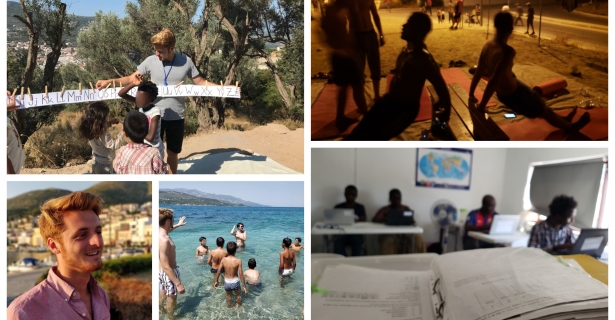Walking through Vathy, the hub of Samos, Greece, I feel like a tourist in a picturesque Greek postcard. Boutiques and stores filled with organic products line the narrow, cobblestone streets, making it easy to forget about last night’s stabbing in the food queue. Luscious Greek garden tavernas with the aroma of gyro meat and fresh seafood mask the ammonia smells of a thousand homeless people without access to a bathroom. The glimmering Aegean Sea beckons any curious soul to basque in its blue waters, a kilometer away from where 25 desperate souls recently contributed to the ever-growing massive underwater grave for EU hopefuls. Tourists blissfully stroll through the white-and-blue architectural sights and the Greek locals happily do business with them. Both are completely oblivious, purposeful or not, of the happenings nearby, on the edge of town, uphill from the idyllic shoreline promenade.
Two blocks away from paradise, trouble brews. The buildings suddenly look worn, the people not so blissful, and the Greek charm, merely a mirage. Walking up the hill further, the sight only becomes further pronounced. The city abruptly ends, and the tents, fences, and containers begin. There are no more Greek locals and tourists, only Africans, Arabs, Kurds, and Persians under heavy supervision by military personnel.
Here lies Samos Refugee Camp. Asylum-seekers from all over the world, primarily from the Middle East and Africa, call this their home. Every person in the camp arrived in small boats, usually a flimsy rubber dingy, with many of them surviving catastrophic sinking incidents.
Life in the Samos HotSpot (another term for the camp) is nothing short of a nightmare. Built originally for about 600 inhabitants, over 5,000 people reside here currently: nine times over-capacity. It is dangerously overcrowded, leaving approximately 40 percent of the camp residents in tents outside of the confines of the camp. Aptly nicknamed the “Jungle”, it is the collection of bushes, woods, and hills surrounding the prison-like camp. Having absolutely no infrastructure or safety from natural hazards, the “Jungle” is the most vulnerable, dangerous, and unsanitary area to live. A majority, however, live inside the camp walls in shipping containers, which hold 50-100 people each. To eat, asylum-seekers must wait in line for hours for horrendous food with little taste and nutrition. There are no laundry services provided by the camp, so people must wash clothes in a creek. Women are especially at risk, with sexual harassment and assault being rampant. Stabbings, stoning, and physical violence are common, often involving dozens of people. Seeing the camp’s only doctor is near impossible and requires waiting in line for days. Rats infest the tents, bed bugs infest the clothes, scabies infest the skin, and trauma infests the brain.
Outside of the camp, most people are not allowed to work, so a sense of purpose is a rare commodity. The treatment of camp residents and people with darker complexions is generally horrendous; many businesses, for example, openly refuse to serve people of color, even volunteers and tourists. The police stop “anyone” at “random” to check for documentation and identification; a white person is never stopped by police. These problems are only the very tip of the iceberg in regard to what asylum-seekers go through on a daily-basis.
To make matters worse, the media has stopped reporting on the “crisis”, especially since the problem went from a manageable short-term problem to a complex, long-term quandary. European Union laws force migrants to stay in the first EU country that they enter, keeping refugees cooped up in Greece for long periods of time. In addition, the EU-deal declared Turkey a “safe” country to seek refuge in, giving Greece the power to deport people back to Turkey if their asylum claims are rejected. The victims of this legislation are the refugees themselves, who cannot travel and work in countries better equipped to aid them. But the Greek locals are also suffering; a stagnating economy and lukewarm tourism market are already overwhelming the Samian people without the thousands of desperate people trying to survive in their backyard. Everyone is losing, and there is not a long-term solution to this political and humanitarian mess.
Quite frankly, it feels extremely wrong to call this a crisis at all. Countries like Turkey and Lebanon have millions of refugees, while Greece has 60,000 in the entire country. It is clear that the crisis is manufactured with xenophobic undertones; people are afraid of Middle Easterners and Africans, not immigrants. There has always been a migrant flow into Europe. This is nothing new, and yet, the “crisis” continues to scare Greeks tremendously. What the Greeks do not understand is the real fears that haunt Samian refugees: the dark realities of being stranded in a refugee camp for years without certainty of the future, the trauma of arriving by dangerous dinghies to Samos, and the cataclysmic horrors that forced people to leave their homes in the first place. This nightmare has no end in sight.

